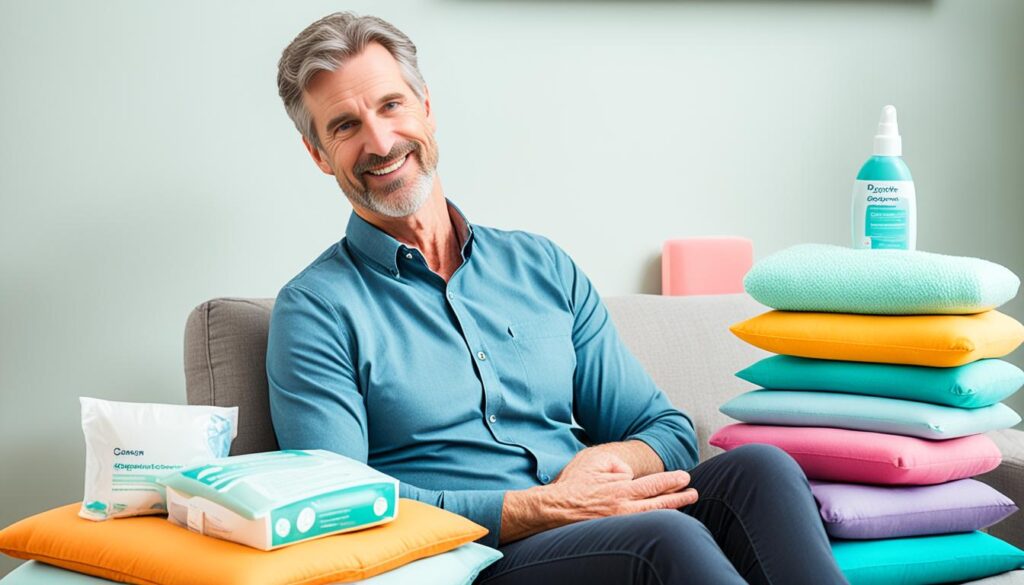|
Getting your Trinity Audio player ready... |
Welcome to the first section of our article on bowel incontinence, also known as fecal incontinence. If you or someone you know struggles with managing bowel movements, you’re not alone. Bowel incontinence is a common condition that can cause stool leakage and a loss of control.
Table of Contents
ToggleIn this section, we’ll explore the various causes of bowel incontinence and provide tips on how to manage this condition effectively. By understanding the underlying factors contributing to bowel incontinence and implementing appropriate strategies, you can improve your quality of life and regain control over your bowel movements.
Continue reading to discover the causes of bowel incontinence and learn how to manage this condition. Let’s begin by examining the potential causes of bowel incontinence.
Treating Bowel Incontinence: Medical and Lifestyle Options
If you’re experiencing bowel incontinence, the first step towards treatment is to consult with a doctor. They will assess your condition and provide guidance on the most suitable management options.
Diet Changes
One of the simplest and most effective ways to manage bowel incontinence is through diet modifications. Your doctor or a registered dietitian can help create a personalized plan tailored to your needs. A diet rich in fiber can help regulate bowel movements and prevent constipation, while avoiding trigger foods like spicy or greasy items can help reduce the risk of diarrhea.
Wearing Absorbent Pads
Another option to manage bowel incontinence is wearing absorbent pads, which can provide a sense of security and prevent embarrassing situations. These pads are discreet and can be easily worn under clothing.
Over-the-Counter Medicines
Over-the-counter medicines such as anti-diarrheal drugs or bulk laxatives can be effective in controlling bowel movements and managing symptoms associated with bowel incontinence. However, it’s crucial to consult with a healthcare professional before starting any medication.
Bowel Training
Bowel training involves setting a routine for bowel movements to help regulate bowel function. By establishing a consistent toilet schedule and dedicating specific times for using the bathroom, you can train your body to have regular bowel movements and reduce the frequency of accidents.
Pelvic Floor Exercises
Pelvic floor exercises, also known as Kegel exercises, help strengthen the muscles that control bowel movements. Regularly practicing these exercises can enhance the control and coordination of your pelvic floor muscles, ultimately improving continence.

By managing and treating bowel incontinence with these lifestyle and medical options, you can significantly improve your symptoms and regain control over your bowel movements. It’s important to remember that what works for one person may not work for another, so it’s essential to work closely with your healthcare team to find the best treatment plan for your specific needs.
| Treatment Options | Description |
|---|---|
| Diet Changes | Modifying your diet to include more fiber and avoid trigger foods |
| Wearing Absorbent Pads | Using discreet pads to manage leakage and provide a sense of security |
| Over-the-Counter Medicines | Medications such as anti-diarrheal drugs or bulk laxatives |
| Bowel Training | Establishing a consistent toilet schedule and routine |
| Pelvic Floor Exercises | Strengthening the muscles controlling bowel movements |
Medical Treatment Options for Bowel Incontinence
When it comes to managing bowel incontinence, doctors have a range of treatment options available based on the cause and severity of the condition. These treatments aim to alleviate symptoms, improve bowel control, and enhance the overall quality of life for individuals. Let’s explore some of the medical treatment options for managing bowel incontinence:
Biofeedback Therapy
Biofeedback therapy is a treatment technique that helps individuals strengthen their pelvic floor muscles and regain control over bowel movements. During biofeedback sessions, sensors are placed on the body to monitor muscle activity. This information is then displayed on a screen, allowing patients to visualize and learn how to effectively contract and relax their pelvic floor muscles.
Sacral Nerve Stimulation
Sacral nerve stimulation involves the use of electrical stimulation to regulate the anal sphincters and rectum. A small device called a neurostimulator is implanted near the sacral nerves, which are responsible for controlling bowel function. The device sends mild electrical impulses to these nerves, helping to improve muscle coordination and restore normal bowel control.
Prescription Medicines
In some cases, doctors may prescribe medications to treat underlying medical conditions that contribute to fecal incontinence. These medications can help manage symptoms and improve bowel function. It is important to consult with a healthcare professional to determine the most appropriate medication based on individual needs and medical history.
Vaginal Balloons and Non-absorbable Bulking Agents
Vaginal balloons and non-absorbable bulking agents are used to provide support and strengthen the anus, improving continence. Vaginal balloons are inserted into the vagina and inflated to put pressure on the rectum, helping to control bowel movements. Non-absorbable bulking agents, such as silicone, are injected into the tissues surrounding the anus to bulk up the area and improve muscle function.
Surgery
In severe cases of bowel incontinence that do not respond to other treatments, surgery may be considered as a last resort. The type of surgery recommended will depend on the underlying cause and individual circumstances. Surgical options may include sphincteroplasty (repair of the anal sphincter muscles), colostomy (creating an opening in the abdomen for waste elimination), or other procedures to correct anatomical abnormalities or damage.
These medical treatment options for bowel incontinence can be highly effective in managing the condition and improving overall bowel control. However, it is essential to consult with a healthcare professional to determine the most suitable treatment plan based on individual needs and circumstances.

Lifestyle Tips for Managing Bowel Incontinence
When coping with fecal incontinence, it’s essential to develop effective strategies to manage your everyday life. By implementing these coping strategies, you can enhance your comfort, confidence, and overall quality of life.
1. Wear Absorbent Pads
Wearing absorbent pads is an effective way to prevent leakage and maintain cleanliness throughout the day. These pads provide discreet protection and can help you feel more secure when going about your daily activities.
2. Carry Cleanup Supplies
When leaving the house, it’s important to carry cleanup supplies and a change of clothes. This ensures that you’re prepared for unexpected accidents and can quickly clean up if they occur. Having these supplies on hand will give you peace of mind and allow you to confidently navigate your daily routines.
3. Find Public Restrooms in Advance
One of the key challenges individuals with fecal incontinence face is finding accessible restrooms when outside of their homes. Take the time to identify nearby public restrooms before the need arises. This proactive approach will enable you to plan your outings more effectively and reduce the anxiety associated with finding a restroom when you need one.
4. Use Fecal Deodorants
Using fecal deodorants can help reduce the smell of stool and gas, providing you with a greater sense of confidence and comfort. These deodorants come in various forms, such as sprays or drops, and can be discreetly used to mitigate any odor-related concerns.
5. Take Over-the-Counter Medicines
Over-the-counter medicines can be helpful in managing symptoms related to fecal incontinence. Anti-diarrheal drugs or bulk laxatives can regulate bowel movements and assist in controlling stool consistency, providing you with more predictable and manageable bowel movements.
By incorporating these coping strategies into your daily routine, you can navigate the challenges of fecal incontinence with greater ease and confidence, ultimately improving your overall quality of life. Remember to consult with your healthcare professional for personalized guidance and recommendations.

Addressing Anal Discomfort
Bowel incontinence can cause anal discomfort, including irritation, pain, and itching. To alleviate these symptoms, it is important to keep the anal area clean and dry. Here are some tips to help relieve anal discomfort:
- Wash the anal area after a bowel movement using mild, fragrance-free soap and warm water. Avoid using harsh soaps or wipes that may further irritate the skin.
- Change soiled underwear promptly to prevent prolonged contact with stool and moisture.
- Use moisture-barrier creams or ointments to protect the skin from further irritation. These products create a barrier between the skin and stool, helping to reduce discomfort and heal any existing irritation.
- Apply non-medicated powders, such as cornstarch or talcum powder, to keep the anal area dry and minimize friction.
- Wear loose-fitting clothes and breathable underwear to allow for airflow and reduce moisture buildup.
By following these practices, you can alleviate anal discomfort and promote healing in the affected area. It is essential to consult with a healthcare professional for personalized advice and treatment options specific to your condition.
| Methods for Relieving Anal Discomfort | Benefits |
|---|---|
| Washing the anal area after a bowel movement | Cleanses the area and removes irritants |
| Changing soiled underwear promptly | Prevents prolonged contact with stool and moisture |
| Using moisture-barrier creams or ointments | Protects the skin from further irritation |
| Applying non-medicated powders | Keeps the anal area dry and minimizes friction |
| Wearing loose-fitting clothes and breathable underwear | Allows for airflow and reduces moisture buildup |

Diagnosis and Tests for Bowel Incontinence
When it comes to diagnosing bowel incontinence, healthcare professionals use a combination of questioning and physical examinations to determine the underlying causes and develop an appropriate treatment plan. During the diagnostic process, several tests may be conducted to assess the function and structure of the rectum, anus, and surrounding muscles.
A physical exam is often the first step in diagnosing bowel incontinence. It involves a comprehensive assessment of the abdomen, genital area, and rectum to detect any abnormalities or signs of muscle or nerve damage.
A digital rectal exam is a specific type of physical examination performed to evaluate the strength of the anal sphincter and identify any irregularities.
Additionally, various specialized tests can provide further insights into the patient’s condition. Some of these tests may include:
- Balloon expulsion test: This test measures the patient’s ability to expel a balloon filled with water or air from their rectum. It helps evaluate the coordination and strength of the pelvic floor muscles.
- Anal manometry: This test involves measuring the pressure within the rectum and anal sphincter to assess their functionality.
- Anorectal ultrasonography: It uses ultrasound technology to create images of the rectum, anal sphincter, and surrounding muscles, providing detailed information about their structure and function.
- Proctography: A proctography, also known as a defecography, uses X-rays or fluoroscopy to assess the rectum and anal sphincter during the process of defecation.
- Colonoscopy: This procedure involves the insertion of a flexible tube with a camera into the rectum and colon to visually examine the intestines for any abnormalities, such as tumors or inflammation.
- Magnetic resonance imaging (MRI): MRI scans may be used to create detailed images of the pelvic area, providing valuable insights into the structure and function of the rectum and surrounding muscles.
These diagnostic tests help healthcare professionals gather comprehensive information about the patient’s condition, enabling them to make an accurate diagnosis and develop an effective treatment plan tailored to the individual’s needs.
Treatment Options for Bowel Incontinence
When it comes to treating bowel incontinence, the approach varies depending on the underlying cause. By addressing the root cause, healthcare professionals can provide targeted treatment options to manage and alleviate symptoms. Here are some common treatment options for bowel incontinence:
Medications
Medications can play a significant role in managing bowel incontinence. Anti-diarrheal drugs, such as loperamide, can help reduce the frequency of loose stools, while bulk laxatives, like psyllium, add bulk to the stool, making it easier to control. Your doctor may prescribe these medications to effectively manage your symptoms.
Exercise and Other Therapies
- Kegel exercises: These exercises strengthen the pelvic floor muscles, which play a crucial role in controlling bowel movements. Regularly practicing Kegel exercises can improve muscle strength and enhance anal sphincter control.
- Biofeedback: Biofeedback therapy uses sensors to provide feedback on muscle activity. By learning to interpret these signals, individuals can gain better control over their bowel movements.
- Bowel training: This technique involves establishing a regular toilet schedule to train the body to have bowel movements at predictable times. Bowel training can help improve bowel control and reduce accidents.
- Bulking agents: Bulking agents, such as fiber supplements, can add bulk and consistency to the stool, making bowel movements more manageable and predictable.
- Sacral nerve stimulation: This therapy involves the placement of a small device, similar to a pacemaker, underneath the skin. It delivers mild electrical impulses to the sacral nerves, helping regulate bowel movements.
- Vaginal balloon: In some cases, a vaginal balloon may be used to provide support and strengthen the anal sphincter muscles, improving bowel control.
- Radiofrequency therapy: This minimally invasive procedure involves delivering heat energy to the anal canal, stimulating the growth of healthy tissue and improving muscle function.
Surgery
In severe cases or when other treatments have not been effective, surgical intervention may be necessary. Surgery can help correct underlying anatomical issues, repair damaged muscles, or create a new way for stool to leave the body, such as a colostomy or an ileoanal reservoir.
Treatment options for bowel incontinence aim to restore muscle strength, improve anal sphincter control, and enhance awareness of the urge to defecate. Your healthcare professional will determine the most appropriate treatment plan based on your individual needs and the severity of your condition.
Remember to discuss any concerns or questions you have about your treatment options with your healthcare provider.
| Treatment Options | Description |
|---|---|
| Medications | Anti-diarrheal drugs and bulk laxatives can help manage bowel incontinence by reducing the frequency of loose stools or adding bulk to the stool. |
| Exercise and Other Therapies | Kegel exercises, biofeedback, bowel training, bulking agents, sacral nerve stimulation, vaginal balloon, and radiofrequency therapy are various therapies that can improve muscle strength, anal sphincter control, and bowel movement awareness. |
| Surgery | In severe cases, surgery may be necessary to correct underlying issues or damage to the rectum or sphincter muscles that are causing bowel incontinence. |
Conclusion
Bowel incontinence can have a significant impact on your daily life, but there are practical ways to manage and improve your symptoms. By seeking help from healthcare professionals and making certain lifestyle changes, you can regain control and enhance your overall quality of life.
One essential aspect of managing bowel incontinence is wearing absorbent pads, which can provide peace of mind and minimize the impact of accidents. Additionally, following a specialized diet recommended by your healthcare provider can help regulate your bowel movements and reduce episodes of incontinence.
Moreover, practicing pelvic floor exercises, such as Kegel exercises, can strengthen the muscles responsible for controlling bowel movements. These exercises, when performed correctly and consistently, can improve your ability to control your bowel function and decrease the frequency of accidents.
If necessary, your healthcare provider may recommend medical treatments such as biofeedback therapy, bowel training, or the use of bulking agents to help manage your symptoms. Remember, addressing bowel incontinence proactively and working closely with your healthcare team can lead to greater comfort and confidence in your daily activities, ultimately improving your overall quality of life.
FAQ
What is bowel incontinence?
Bowel incontinence, also known as fecal incontinence, is a condition where individuals have difficulty controlling their bowel movements, leading to stool leakage and loss of control.
What are the causes of bowel incontinence?
Bowel incontinence can be caused by muscle damage, nerve damage, diarrhea, constipation, and underlying medical conditions like irritable bowel syndrome or Crohn’s disease.
How can bowel incontinence be managed?
Bowel incontinence can be managed through a combination of treatments such as diet changes, medications, exercises, and in some cases, surgery. Consulting with a healthcare professional is the first step in managing and treating bowel incontinence.
What are some simple treatments for bowel incontinence?
Simple treatments for bowel incontinence include diet changes, wearing absorbent pads, over-the-counter medicines for diarrhea or constipation, bowel training, and pelvic floor muscle exercises.
What are the medical treatment options for bowel incontinence?
Medical treatment options for bowel incontinence include biofeedback therapy, sacral nerve stimulation, prescription medicines, vaginal balloons, non-absorbable bulking agents, and in severe cases, surgery.
How can I cope with bowel incontinence?
Coping with bowel incontinence involves wearing absorbent pads, carrying cleanup supplies and a change of clothes, finding public restrooms, using fecal deodorants, and building a routine around toilet use.
How can I relieve anal discomfort caused by bowel incontinence?
To alleviate anal discomfort, it is important to keep the anal area clean and dry by washing after a bowel movement, changing soiled underwear promptly, and using moisture-barrier creams or non-medicated powders.
How is bowel incontinence diagnosed?
Bowel incontinence is diagnosed through questioning about symptoms and physical examinations. Additional tests may be conducted to evaluate the function and structure of the rectum, anus, and surrounding muscles.
What are the treatment options for bowel incontinence?
Treatment options for bowel incontinence include medications, exercise and other therapies like Kegel exercises and biofeedback, bowel training, bulking agents, sacral nerve stimulation, vaginal balloon, radiofrequency therapy, and surgery in some cases.


